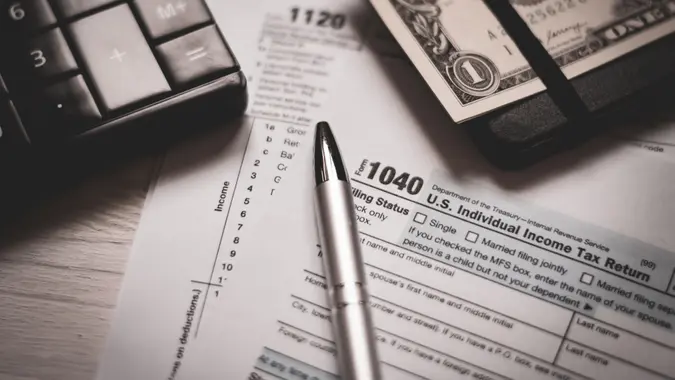Tax Returns: Are COVID-19 and Other Medical Deductions Possible for 2022?

Commitment to Our Readers
GOBankingRates' editorial team is committed to bringing you unbiased reviews and information. We use data-driven methodologies to evaluate financial products and services - our reviews and ratings are not influenced by advertisers. You can read more about our editorial guidelines and our products and services review methodology.

20 Years
Helping You Live Richer

Reviewed
by Experts

Trusted by
Millions of Readers
Many of the tax deductions Americans were able to take advantage of during the height of the pandemic in 2020 and 2021 have now expired for 2022 tax returns, such as the Expanded Child Tax Credit or the increases to the Earned Income Tax Credit.
But, there are still some ways to write off health expenses related to COVID-19 if you were impacted last year.
You can claim healthcare costs for you, your spouse or your dependents if the out-of-pocket contributions were extensive. While the cost of copious test kits or Paxlovid prescriptions may not be applicable, if a member of your household was hospitalized for a long COVID battle, deducting the cost may bring down your taxes owed. This also applies to any general medical care costs beyond COVID infections where bills added up.
The IRS allows medical and dental bills to be itemized and deducted if they total more than 7.5% of your Adjusted Gross Income (AGI). For example, if your AGI was $80,000, 7.5% would be $6,000 — so if you paid $6,000 or more in qualifying medical expenses, then you’d be able to deduct anything over that threshold. If you paid $15,000 in out-of-pocket medical bills, you could deduct $9,000 from your AGI.
To do so, you’ll need to use Schedule A on Form 1040 to list out the expenses — it’s important to keep documentation in case the IRS questions any of the claims.
It’s also good to know what qualifies as medical care as it relates to tax deductions. Per the IRS website, “Medical expenses are the costs of diagnosis, cure, mitigation, treatment, or prevention of disease, and for the purpose of affecting any part or function of the body” and are inclusive of services that are provided by physicians, surgeons, dentists and other qualifying medical practitioners. It may also include the cost of related equipment, devices and supplies, as well as insurance premiums and transportation to receive care.
However, the IRS is quick to note this doesn’t “include expenses that are merely beneficial to general health, such as vitamins or a vacation.”
The deductions can be for any care for yourself, your spouse (if you file jointly) or any qualifying dependents as long as you were married or a guardian at the time medical services were rendered or paid for. And again, it must be clear these were out-of-pocket expenses. There are a few other examples of those who may qualify on your tax return, as listed on the IRS website.
On the website you can also find the full list of what is an eligible medical expense. Some examples include:
- Acupuncture
- Ambulance services
- Chiropractor
- Contact lenses
- Crutches
- Dental care
- Eye care and surgeries
- Hearing aids
- Home improvements required for a patient
- Hospital stays
- Insurance premiums
- Medical legal fees
- Nursing services
- Oxygen
- Prescriptions
- Service animals
- Surgery
- Therapy
These deductions can also apply for state tax returns, where many times the threshold is lower than the federal 7.5% rate. It’s best to check your state’s official website for more information or inquire with your professional tax advisor.
More From GOBankingRates
 Written by
Written by  Edited by
Edited by 

























